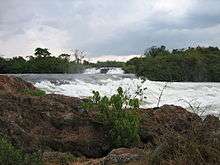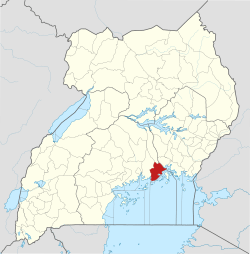Bujagali Hydroelectric Power Station
The Bujagali Power Station is a hydroelectric power station across the Victoria Nile that harnesses the energy of its namesake; the Bujagali Falls, in Uganda. Construction began in 2007 and concluded in 2012. It was officially inaugurated on 8 October 2012 by Ugandan President Yoweri Museveni and Aga Khan IV in the presence of African politicians and investors.[1]
| Bujagali Dam | |
|---|---|
 River Nile, 5 km (3 mi) downstream of Bujagali Dam. | |
 Location of Bujagali Power Station Placement on map is approximate  Bujagali Hydroelectric Power Station (Africa) .svg.png) Bujagali Hydroelectric Power Station (Earth) | |
| Location | Bujagali, Uganda |
| Coordinates | 00°29′54″N 33°08′15″E |
| Construction began | 2007 |
| Opening date | 2012 |
| Construction cost | US$862 million |
| Dam and spillways | |
| Type of dam | Gravity dam |
| Impounds | River Nile |
| Power Station | |
| Turbines | 5 |
| Installed capacity | 250 MW (340,000 hp) |
The capacity of the power station is 250 megawatts. The station was the largest hydroelectric energy source in Uganda, at the time it was commissioned. However, the planned Karuma and Ayago power stations would be larger. The funding for the station was a source of some concern, as investors joined and departed from the project. As of July 2014, the plant was managed by Bujagali Energy Limited, which selected Italian contractor Salini Impregilo to develop the project.[2]
Location
The power station lies across the Victoria Nile, about 15.5 kilometres (10 mi) north-west of the central business district of the city of Jinja and immediately north of the former location of the Bujagali Falls.[3] It is at the border between Buikwe District to the west and Jinja District to the east. The coordinates of Bujagali Power Station are 0° 29'54.00"N, 33° 08' 15.00"E (latitude:0.498325; longitude:33.137500).[4]
History
As far back as 2001, the government of Uganda started to plan the construction of a hydroelectric power plant at Bujagali Falls. The original developers included AES Energy from the United States and the Madhvani Group from Uganda. In the midst of fraud investigations,[5] the first project was abandoned in 2003 when AES Energy pulled out of the deal, citing a protracted process because of objections from environmentalists.[6][7] The project was delayed due to protracted negotiations between investors and representatives of the Soga cult of the water spirit Budhagaali, whose main shrines were seen as inextricably linked to the strength of the waterfall. Ultimately agreement was reached between the parties.[8]
A new consortium, Bujagali Energy Limited, was created by Sithe Global Power LLC, from the United States, and Industrial Promotion Services, a division of the Aga Khan Fund for Economic Development, and was tasked with developing the project.[9] Construction of the dam and powerhouse started in June 2007. Salini Impregilo was selected to be the lead contractor.[10] The power station began commercial operations on 1 August 2012.[7] At the peak of construction activity, the project employed over 2,500 people, including about 2,200 Ugandan nationals.[11]
Ownership
As of September 2016, the shareholders in Bujagali Energy Limited were as outlined in this reference.[12] In May 2018, the Daily Nation newspaper reported that Jubilee Holdings Limited was set to invest an additional KSh4.4 billion (US$44 million) in the business, in addition to the KSh5.5 billion (US$55 million) that it had already invested.[13]
| Rank | Name of Owner | Percentage Ownership |
|---|---|---|
| 1 | Jubilee Investment Company[14] | |
| 2 | Government of Uganda[12] | |
| 3 | Sithe Global Power | 65.0[12] |
| 4 | Industrial Promotion Services[12] | |
| 5 | Aga Khan Fund for Economic Development[12] | |
| Total | 100.0 | |
Construction costs
The estimated costs for the dam and power plant was US$800 million. Another $62 million was spent on building a high voltage transmission line from Jinja to Kawanda, near Kampala, a distance of about 80 kilometres (50 mi). Bujagali Energy Limited invested approximately US$190 million of its own money into the project. The rest of the funds were borrowed from the following international lenders:[15]
- International Finance Corporation (IFC), a member of the World Bank Group
- African Development Bank
- European Investment Bank
- German Investment Corporation
- KfW
- PROPARCO of France
- French Development Agency
- Netherlands Development Finance Company
- Absa Group Limited
- BNP Paribas
- Nedbank
- Standard Chartered Bank
In March 2018, the Board of Directors of IFC and MIGA approved plans to refinance in excess of US$400 million in construction debt owed by Bujagali Energy Limited, the project SPV. The approval includes US$423 million in guarantees, in support of the project. The refinancing will extend the tenor of the existing loans made in 2007, by the lenders listed above. This, along with tax waivers from he Ugandan government, will lower the cost of electricity to the consumer and stimulate economic growth in the country, where only 26 percent of the population (8 percent in rural areas) had access to grid-electricity at that time.[16]
Completion date
The project was completed in 2012, although partial power generation started in 2011.[17]
In April 2010, The EastAfrican, a Kenyan weekly publication, indicated that the opening of the dam would be phased, one unit at a time.[18] On 2 February 2012, Ugandan newspapers reported the commissioning of the first turbine of the power station.[19] In May 2012, the third 50 megawatt turbine was commissioned, bringing output to 150 megawatts.[20] On 15 June 2012, Ugandan press reports indicated that the fourth and fifth turbines had come online, bringing total output to 250 megawatts. The plant officially began commercial operation on 1 August 2012.[21][22]
On 8 October 2012, the project was officially inaugurated by Ugandan President Yoweri Museveni and Aga Khan IV in the presence of African politicians and investors.[23]
The cost of power
As of October 2016, the dam's utilization rate was approximately 70 percent. The power generated cost the end user about US$0.11/kilowatt-hour, which was the highest rate in the East African Community.[24] In September 2016, the government of Uganda began negotiations with equity partners and lenders to restructure the financing of the dam to reduce the cost to the end-user to about US$0.072/kilowatt-hours.[24]
See also
- List of power stations in Uganda
- Nalubaale Hydroelectric Power Station, another dam upstream on the White Nile
References
- Environmental Justice Atlas (18 December 2015). "Bujagali hydropower project, Uganda". Barcelona, Spain: Environmental Justice Atlas. Retrieved 3 August 2020.
- Google (3 August 2020). "Distance Between Downtown Jinja And Bujagali Hydroelectric Power Station" (Map). Google Maps. Google. Retrieved 3 August 2020.
- Google (3 August 2020). "Location of Bujagali Hydroelectric Power Station" (Map). Google Maps. Google. Retrieved 3 August 2020.
- Pallister, David (3 November 2003). "Africa Dam's Passage 'Eased by Bribes'". The Guardian. Retrieved 22 April 2014.
- Lilley, Sasha (28 August 2003). "AES Backs Out of Bujagali Dam Project". CorpWatch. Retrieved 22 April 2014.
- Kasita, Ibrahim (7 October 2012). "Evolution of the 250MW Bujagali Dam". New Vision. Kampala. Retrieved 7 March 2015.
- Reid, Richard (2017). A History of Modern Uganda. United Kingdom: Cambridge University Press. pp. 287–288. ISBN 978-1-107-06720-2.
- "About Bujagali Energy Limited". Bujagali Energy Limited. Archived from the original on 23 August 2014. Retrieved 22 April 2014.
- "Bujagali Falls Hydropower Dam, Jinja, Uganda". Power Technology. Retrieved 22 April 2014.
- Mugabi, Frank (1 April 2015). "Bujagali Dam Near Completion". New Vision. Kampala. Retrieved 14 November 2018.
- Daniel Kalinaki (4 September 2016). "Uganda urges Bujagali investors to take haircut on project to reduce power costs". The EastAfrican. Nairobi. Retrieved 1 June 2018.
- John Mutua (31 May 2018). "Jubilee Holdings to pump Sh4.4bn into Bujagali power plant". Daily Nation. Nairobi. Retrieved 1 June 2018.
- Juma, Victor (23 May 2014). "Jubilee Wins 30-Year Pact to Operate Bujagali". Daily Monitor. Retrieved 1 June 2018.
- Daily Monitor Reporter (12 April 2011). "Nile Diverted Through Bujagali Powerhouse". Daily Monitor. Kampala. Retrieved 22 April 2014.
- Press Release (8 March 2018). "IFC and MIGA Boards Support Bujagali Refinancing Package to Reduce Ugandan Electricity Costs". Washington, DC: International Finance Corporation. Retrieved 1 June 2018.
- "Uganda Infrastructure Report Q1:2010". Companies and Markets. Archived from the original on 5 October 2011. Retrieved 22 April 2014.
- Barigaba, Julius (12 April 2010). "Bujagali Power Project To Come On Stream Unit By Unit In 2011". Nairobi: The EastAfrican. Retrieved 5 May 2014.
- Walubiri, Moses (2 February 2012). "Bujagali Dam Opens Today". New Vision. Retrieved 4 May 2014.
- Kakamwa, Charles (1 June 2012). "Vice President Commissions Third Bujagali Dam Unit". Kampala: New Vision. Retrieved 5 May 2014.
- "Bujagali: Powering Uganda From The Nile" (PDF). International Water Power & Dam Construction. March 2013. Archived from the original (PDF) on 22 October 2013. Retrieved 5 May 2014.
- Ketchum, Ryan (1 November 2012). "Developing Bujagali, the Largest Private Sector Investment in Uganda". Hydroworld.com. Retrieved 31 May 2016.
- "7 Largest Hydropower Stations in Uganda". World Energy. Retrieved 16 July 2020.
- Daniel K. Kalinaki (16 October 2016). "Uganda to extend Bujagali tax breaks beyond mid-2017 over high power tariffs". The EastAfrican. Nairobi. Retrieved 16 October 2016.

